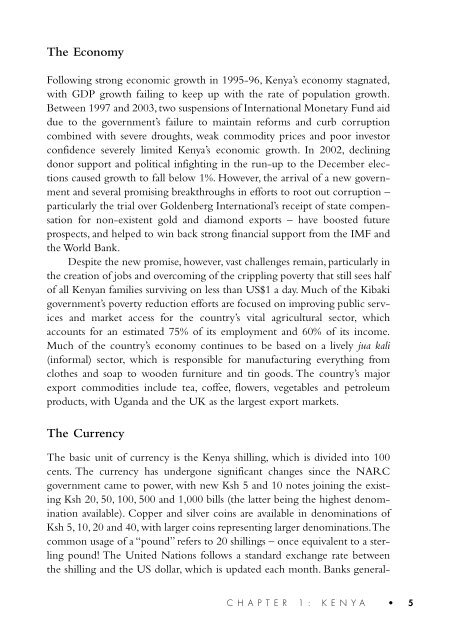KARIBU KENYA - UNON - the United Nations Office at Nairobi
KARIBU KENYA - UNON - the United Nations Office at Nairobi
KARIBU KENYA - UNON - the United Nations Office at Nairobi
You also want an ePaper? Increase the reach of your titles
YUMPU automatically turns print PDFs into web optimized ePapers that Google loves.
The Economy<br />
Following strong economic growth in 1995-96, Kenya’s economy stagn<strong>at</strong>ed,<br />
with GDP growth failing to keep up with <strong>the</strong> r<strong>at</strong>e of popul<strong>at</strong>ion growth.<br />
Between 1997 and 2003, two suspensions of Intern<strong>at</strong>ional Monetary Fund aid<br />
due to <strong>the</strong> government’s failure to maintain reforms and curb corruption<br />
combined with severe droughts, weak commodity prices and poor investor<br />
confidence severely limited Kenya’s economic growth. In 2002, declining<br />
donor support and political infighting in <strong>the</strong> run-up to <strong>the</strong> December elections<br />
caused growth to fall below 1%. However, <strong>the</strong> arrival of a new government<br />
and several promising breakthroughs in efforts to root out corruption –<br />
particularly <strong>the</strong> trial over Goldenberg Intern<strong>at</strong>ional’s receipt of st<strong>at</strong>e compens<strong>at</strong>ion<br />
for non-existent gold and diamond exports – have boosted future<br />
prospects, and helped to win back strong financial support from <strong>the</strong> IMF and<br />
<strong>the</strong> World Bank.<br />
Despite <strong>the</strong> new promise, however, vast challenges remain, particularly in<br />
<strong>the</strong> cre<strong>at</strong>ion of jobs and overcoming of <strong>the</strong> crippling poverty th<strong>at</strong> still sees half<br />
of all Kenyan families surviving on less than US$1 a day. Much of <strong>the</strong> Kibaki<br />
government’s poverty reduction efforts are focused on improving public services<br />
and market access for <strong>the</strong> country’s vital agricultural sector, which<br />
accounts for an estim<strong>at</strong>ed 75% of its employment and 60% of its income.<br />
Much of <strong>the</strong> country’s economy continues to be based on a lively jua kali<br />
(informal) sector, which is responsible for manufacturing everything from<br />
clo<strong>the</strong>s and soap to wooden furniture and tin goods. The country’s major<br />
export commodities include tea, coffee, flowers, vegetables and petroleum<br />
products, with Uganda and <strong>the</strong> UK as <strong>the</strong> largest export markets.<br />
The Currency<br />
The basic unit of currency is <strong>the</strong> Kenya shilling, which is divided into 100<br />
cents. The currency has undergone significant changes since <strong>the</strong> NARC<br />
government came to power, with new Ksh 5 and 10 notes joining <strong>the</strong> existing<br />
Ksh 20, 50, 100, 500 and 1,000 bills (<strong>the</strong> l<strong>at</strong>ter being <strong>the</strong> highest denomin<strong>at</strong>ion<br />
available). Copper and silver coins are available in denomin<strong>at</strong>ions of<br />
Ksh 5, 10, 20 and 40, with larger coins representing larger denomin<strong>at</strong>ions.The<br />
common usage of a “pound” refers to 20 shillings – once equivalent to a sterling<br />
pound! The <strong>United</strong> <strong>N<strong>at</strong>ions</strong> follows a standard exchange r<strong>at</strong>e between<br />
<strong>the</strong> shilling and <strong>the</strong> US dollar, which is upd<strong>at</strong>ed each month. Banks general-<br />
CHAPTER 1: <strong>KENYA</strong> • 5


